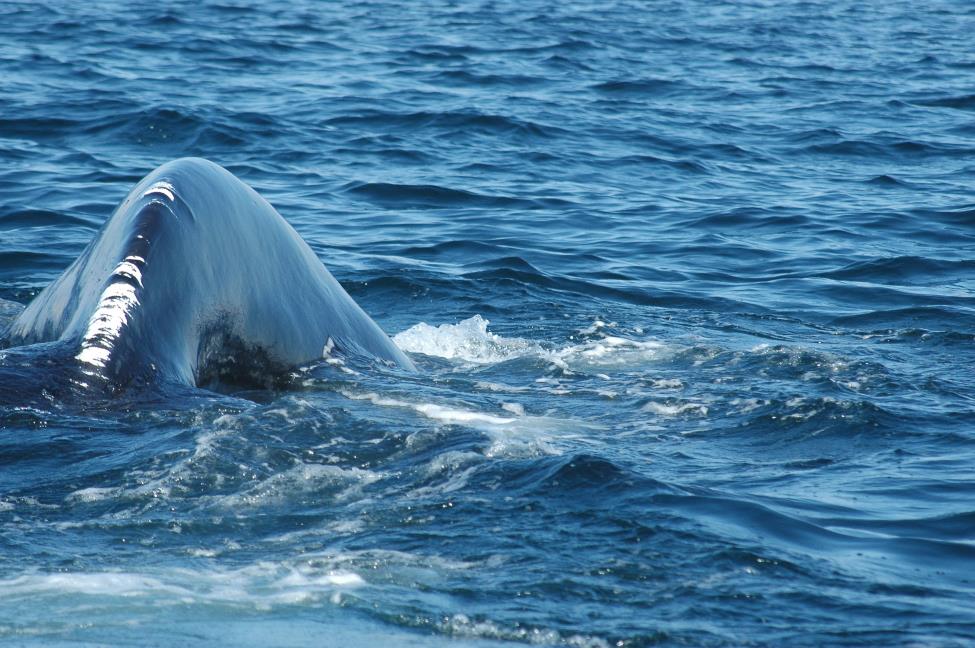

Seventh North Atlantic Right Whale Calf of 2018-2019 Calving Season Sighted Off Georgia
February 20, 2019

Pico (#3270) swims with her new calf near St. Catherine's Island off the coast of Georgia on February 14, 2019.
credit: Sea to Shore Alliance, permit #20556-01
The seventh North Atlantic right whale calf of the 2018-2019 calving season was sighted near St. Catherines Island off the coast of Georgia on February 14, 2019. The mother is Pico (#3270), she is at least 17 years old as she was first sighted in 2002. This is her second known calf - she gave birth to her first calf in 2011. She is regularly seen in the Great South Channel off the coast of New England and in the Bay of Fundy off the coast of Nova Scotia and her most recent sighting before February 14th that's listed in the New England Aquarium's North Atlantic Right Whale Catalog was on April 30, 2017 in the Great South Channel.
Pico has extensive scarring at the base of her flukes from at least two previous entanglements in fishing rope but somehow managed to shed the rope and keep going. If she hadn't survived those entanglements we would not only have lost Pico, we would not have either of her calves in the population as both of her entanglements occurred before she gave birth to her first calf. Her gap of 8 years between calves is concerning because North Atlantic right whales should be giving birth every 3-4 years. It's also been shown that even entanglements that aren't deadly are affecting the females in the population bad enough that it's lowering the birth rates and increasing the calving interval. The Northeast Fisheries Science Center (NEFSC) state in that report, "The energy demands from the drag associated with entanglement can reduce the likelihood that a female can successfully reproduce. Years between births also increases for females given the recovery period needed from the physical costs of entanglements, which can last from months to years." Of the 7 mothers that have given birth so far this year, 4 of them - #2791, #3317, #4180 and Pico (#3270) - have scars from at least one previous entanglement in fishing rope. The scarring on #4180 and Pico is extensive and as noted above, Pico has been entangled at least twice.

The extensive scarring from at least two previous entanglements in fishing rope cover the base of Pico's flukes as she dives in the Bay of Fundy in Canada on September 15, 2009.
credit: New England Aquarium
Seven births is great news, especially since there were no calves seen in 2018 and only five in 2017. However, 7 calves is tied for the fourth lowest in 20 years (0 in 2018, 1 in the 1999/2000 season, 5 in 2017 and 7 in 2012). The population has also dropped from an estimated 451 in 2016 to 411 at the end of 2017 with a record 17 known deaths in 2017 and 3 known deaths in 2018. Since there were at least 20 deaths and only 5 calves in that time there would need to be at least 16 new calves to grow the population. Researchers also believe that they usually only see only 1 out of every 3 deaths (although the large amount that were killed in Canada in 2017 were mostly in a fairly limited area so we don't believe the 1/3 number applies there).
Entanglements in rope from lobster and snow crab traps and ship strikes are the two major threats to North Atlantic right whales. The two entanglements that Pico has suffered clearly show how fragile the situation is for these whales. We are celebrating these seven calves and are hoping that there are many more to come but for these whales to grow their population and truly thrive we need to do much more to protect them.
To find out more about what is happening to North Atlantic and North Pacific right whales and how we can all take actions in our everyday lives to protect them, please visit our Facts and Action sections on our website. We also post updates and pictures on Facebook, Tumblr and Twitter.